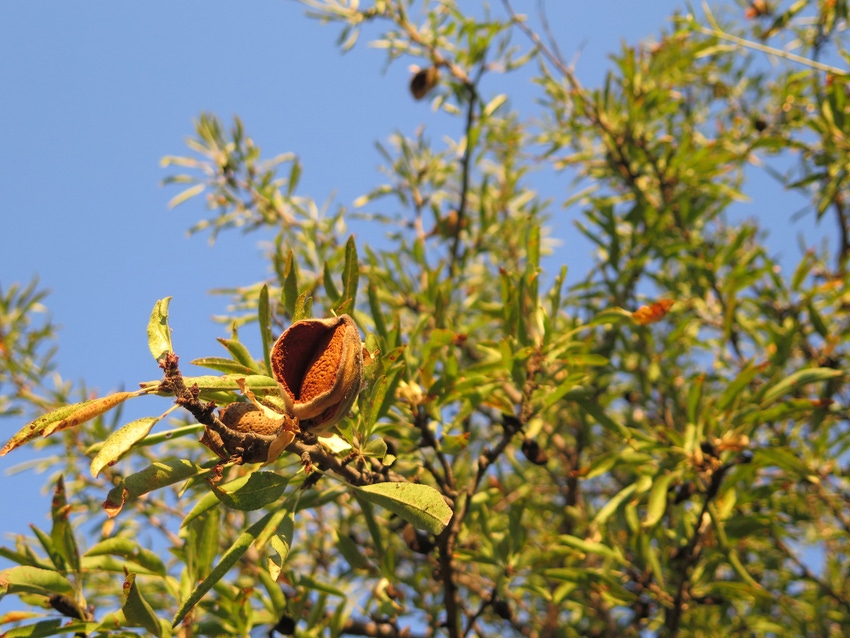October 20, 2016

Kevin Costner, in the role of cross country coach Jim White, assembles his runners beside white-tarped mounds of almond hulls in Kern County’s flat land in the movie “McFarland USA.”
“We don’t have hills,” he tells them. “These are our hills. What happened to us in Palo Alto is never going to happen again.”
The runners proceed to run up and down mound after mound. It’s visually striking and helps the plot move forward. But it’s probably something the owner of those hulls might not be thrilled about, and it’s something that likely wouldn’t please owners of other tarp-covered mounds – of stockpiled almonds.
Given projections of a California almond crop of more than two billion pounds for 2016, it’s a good bet there will be a number of those almond mounds across the San Joaquin Valley and elsewhere.
“With the increase in almond plantings over the past few years, processing delays will become more common,” wrote David Doll, a University of California Cooperative Extension (UCCE) farm advisor in Merced County, in a blog posting. “While waiting to be processed, almonds are usually stockpiled.”
Doll points to the advantages of stockpiling, including getting the almonds out of the orchard sooner to allow for post-harvest practices, to reduce in-field insect infestations, and to allow greater flexibility in scheduling transport to processors.
He also advises on steps that should be taken to avoid damaging the almonds in storage. And much the same advice was given by the Almond Board of California (ABC) in a separate posting in which it said “more crop than ever may be subject to stockpiling.”
Both sources issued links to additional information. The ABC directed readers to this website - http://www.almonds.com/sites/default/files/content/attachments/grower_stockpile_management_best_practices_from_abc_2014.pdf .
Doll published a link to work by UC researchers Bruce Lampinen, Themis Michailides, and others on the subject at http://www.almondboard.com/PR/U.2009.09-AFLA2-Lampinen.Lampinen.Almond%20Stockpile%20Monitoring%20for%20Aflatoxin%20Potential.pdf.
Here are 10 ABC-UCCE suggested ways to avoid almond damage during storage.
1: When stockpiling, Doll says make sure the total moisture content for the in-hull almonds is less than 9 percent. He says hulls should snap when bent.
2: “Choose a location that is suitable for drainage in rainy weather and that is not near equipment or fuel storage,” Doll says. “Stockpiles should be oriented in a north-south direction to aid in drying, and covered with white-on-black tarps.”
3: Placing the white side up reflects heat and solar radiation and reduces the heat in the pile, he says. The tarps help reduce humidity and day-to-night heat fluctuations, leading to a reduction in condensation.
It’s best to monitor humidity and open the tarp when appropriate to reduce condensation and mold formation. Also, monitor and treat for insect, bird, and rodent pests. If rain threatens, ensure piles are covered.
The stockpiles are a potential fire hazard, Doll adds.
4: The stockpile should be fumigated to reduce insect damage, he explains.
“The navel orange worm is an excellent storage pest and can survive in stockpile conditions,” Doll says. “Furthermore, this pest can continue to feed and reproduce within stockpiles, increasing damage as well as alfatoxin risk. Although time consuming, fumigation is critical in killing larvae and eggs, reducing damage.”
A commonly used fumigant is aluminum phosphide.
5: Hull moisture above 14 percent and a holding temperature greater than 120 degrees can increase the risk for concealed damage, mold, and alfatoxin, Doll notes. With an earlier harvest, stockpiles can be exposed to higher temperatures.
“If needed, delay harvest until nuts can dry,” he says. “This will be increasingly necessary as orchard canopy coverage increases as cooler temperatures and more shade increases dry times.
Avoid windrowing until nuts are close to the desired moisture levels.”
6: It’s best, if harvesting the later varieties in rainy conditions, to keep the nuts in the tree if possible to aid in drying, says Doll. If the nuts are already on the ground, try to encourage drying by removing leaves, twigs, and other material. This may take several passes with the pick-up machine or conditioner.
7: The Almond Board says the tops of tarps should be smoothed so they are flat.
8: The almond group also states the importance of controlling alfatoxins, which pose a health threat, and it recommends sampling nuts for moisture levels before sweeping.
“Take samples of the ‘worst case’ almonds – those on the north side of the canopy next to the tree trunk - when moisture tends to range about 2 percent higher than other areas of the orchard,” the board says. “Within the windrow, moisture tends to accumulate on the bottom layers of almonds, so be sure to choose those to sample.”
9: Another consequence of moisture at harvest is concealed damage, which can significantly impact quality and reduce grower returns in years with late harvests and-or early rains. The board’s guidelines note that “concealed damage” is apparent only after roasting, when the kernel interiors turn darker than undamaged nuts, and flavor can be bitter.
In extreme cases, kernel internal color and flavor are altered before roasting. Prolonged moisture at elevated temperatures (above field temperatures) and even at ambient temperatures can create this condition.
You May Also Like




